Unsure about your French table manners? Click Here to download > > How to avoid these 10 food etiquette mistakes !
- Home ›
- Plan Your France Trip ›
- Driving Tips
Driving In France: How To Survive Our (Sometimes) Ridiculous Rules
Updated 8 September 2024 by Leyla Alyanak — Parisian by birth, Lyonnaise by adoption, historian by passion
Driving in France isn't for the uninitiated. Our rules can be confusing, our drivers excessive, and our fines high. But it won't take much to learn how to drive in France: I set it all out for you below.
Travel in France by car can be abominable or heavenly, depending on how much you know before you get behind the wheel.
My goal here is to showcase the good, the bad, and the just plain ugly driving behavior of my compatriots, and to highlight the most common rules of the road, especially the ones easiest to break.
Essential rules for driving in France
- Speed limits and signage
- Priority to the right (priorité à droite)
- Roundabouts and traffic circles
- No right turn on red
- A few more things to know
Toll roads and how to navigate them
Driving in French cities vs. rural areas
- Driving in major French cities (Paris, Marseille, Lyon...)
- Navigating rural roads and villages
- Sharing the road with cyclists
Tips for renting a car in France
Driving through scenic routes in France
NOTE: Pages on this site may contain affiliate links, which support this site. See full Privacy Policy here.
Essential rules for driving in France
First, I'm not a driving instructor or a cop, nor am I the world's best driver. I'm just your garden variety French motorist, and I'm not blind to my countrymen's (the worst offenders do tend to be men, according to insurance companies) road manners.
I care about safety, yours and mine, so these tips on driving in France are going to be brutally honest.
This is not full rundown of driving rules in France: it is a highlight of the absolute, must-know basics for driving in France as a tourist, with a spotlight on rules that are counter-intuitive at best, illogical, stupid, or at worst, even dangerous. (If you're more comfortable learning by seeing, this excellent online driving course teaches you what you need to know about driving in France.)
NOTE: Things change and driving laws in France evolve, so none of this information is legal advice. To make sure, please check official sources.
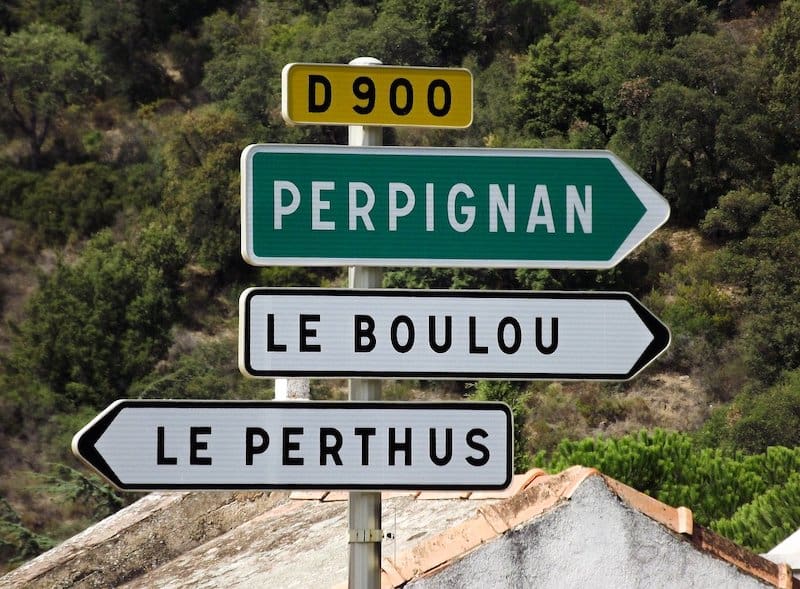
Speed limits and signage
This may be the most disconcerting sight on French roads: with overhead speed cameras snapping your every move and radars at the ready, you'll be toodling along, well within the speed limit, when a gust of wind to your left (and sometimes to your right) will signal either a cyclone (in France?) or a car passing you at such high speed it is almost out of sight by the time you recover.
Whether it's Gallic stubbornness or an ego-driven desire to show off, chances are you'll be tailgated if you stick carefully to the France speed limits. Just ignore the tailgaters. You'll probably soon see them by the side of the road, being ticketed. So satisfying.
It's worse on country roads, where passing is more difficult because of narrower roads and oncoming traffic. But that doesn't stop anyone.
So what are the speed limits in France?
- Motorways and autoroutes: 130 kph (110 in the rain)
- Dual carriageway: 110 kph (100 in the rain)
- Two-way road without a central separation: 80 kph, 90 in some departments (you either have to know ahead of time, or there will be speed limit signs on the road)
- City and town: 50 kph (often going down to 30 but it will be marked)
To give you an idea of conversions, 130 kph is about 80 mphe
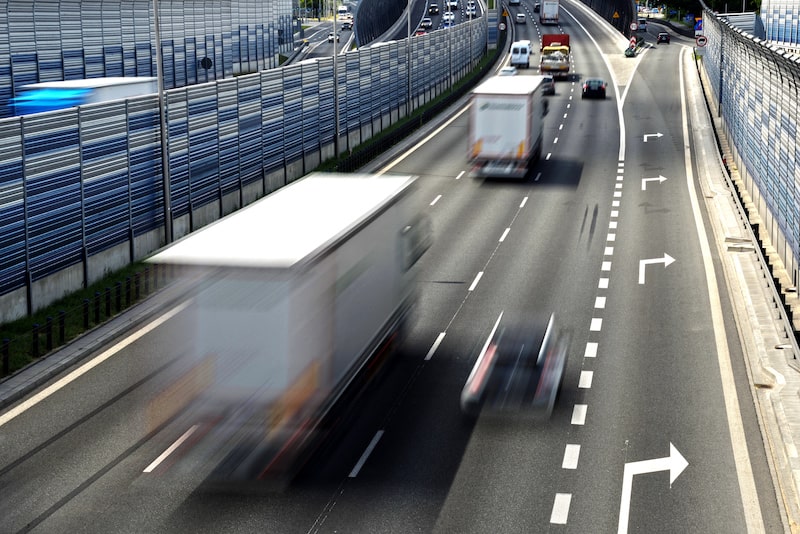
Priority to the right (priorité à droite)
Please don't skip over these words just because they're in French - this may be the most important driving rule you'll learn in this country.
Basically, priorité à droite means this: anyone coming from your right has right of way, even if they're joining a main road from a tiny village track.
So it's simple. Assume people coming from your right have priority, UNLESS something says they don't, like:
- a STOP sign facing merging traffic from the right, which means they have to stop (and which by some magical X-ray vision you're supposed to see from the back as you drive by)
- a solid white line painted on the ground where you'd expect a Stop sign to be
- and the main one: a priority sign on YOUR road. If you see this sign on your road, you can drive on without a worry.
Otherwise, assume traffic coming from your right has priority. Utterly ridiculous. If people actually obeyed this, they'd be coming to a near stop every few seconds, fearfully checking all the little streets and roads on their right.
But yes, be very vigilant. Unless you see the big yellow priority sign on YOUR road, assume some slow-moving electric car can simply swerve out in front of you, unannounced.
And if that big yellow and white sign has a thick black diagonal line through it? It simply means you no longer have priority.
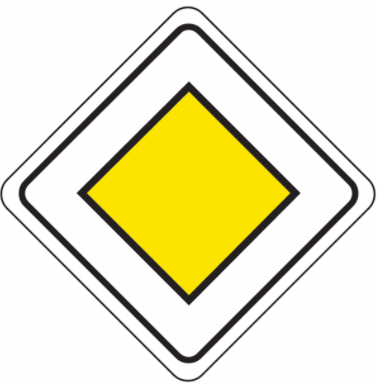 You have priority
You have priority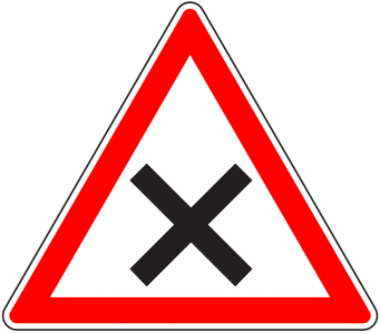 Crossroad ahead but you don't have priority
Crossroad ahead but you don't have priority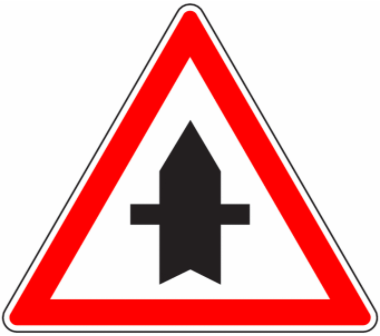 Crossroad ahead but you do have priority
Crossroad ahead but you do have priorityThis kind of priority on the right rule may work well in Paris, when you're merging ten lanes of traffic onto the Place de l'Étoile, but otherwise, it's nerve-wracking and in my humble opinion, more dangerous than the dangers it was probably designed to avoid.
And if I insist on this one, it's because this is THE one that will probably cause you the most angst.
This rule is just as confusing for us French, by the way, not just for foreigners.
In a logical world, things would be the other way around: you would simply have priority on a main road, or on the bigger road. Any exception would be signalled.
But this is France.
Roundabouts and traffic circles
France loves its roundabouts; we have about 43,000 of them, or about half the roundabouts in the world, not bad considering this bit of traffic equipment was "invented" in the UK, which has a modest 26,000...
Usually, priority is given to the vehicle already IN the roundabout. But there are a few exceptions.
Here's one that trumps them all: the scariest roundabout in France, the Place de l'Étoile in central Paris, gives priority to those ENTERING the roundabout. That's right. Just plunge in, and anyone on your left (you're coming from their right) will stop. Unless they're a tourist who doesn't know the rules.
A few other roundabouts (including one in a village near me) also give priority to those already engaged in the roundabout. When this is the case, there will be a sign facing you before you enter the traffic circle, with the words "Vous n'avez pas la priorité", you do not have the priority.
Heed this or be scrunched.
No right turn on a red light
There are countries and states or provinces where you are allowed to turn right on a red traffic light when it is safe.
Not so in France. Don't even think it. Red means red. Stop until it turns green.
A few more things to know
- Seat belts are compulsory, in both front seat and back seats. But that's just common sense.
- There are certain compulsory items for driving in France. These include storing bright yellow reflective jackets in your car (one per person), as well as an emergency warning triangle to signal distress.
- If you're from Britain and are driving your own car, make sure you use beam deflectors so that you don't blind oncoming traffic. You should be able to buy these on the ferry across and they're a requirement for driving in France with British cars.
- Our motorways can be crowded with trucks and if you have a tiny car that wiggles in the wind, try to drive when trucks are off the road, either at night, or on Sundays, where only refrigerated trucks are allowed, or over lunch, when drivers are, well, eating lunch. Other good times to be on the road are very early morning (trucks, but few cars, and people haven't had wine yet) and after 7:30 pm, when truckers have stopped for the day and everyone else is home for supper.
Also watch out for...
- the size of cars, possibly smaller than you may be used to
- the narrowness of roads and streets, especially in small villages, sometimes barely wide enough for two cars
- steep inclines and frequent curves
- aggressive and short-tempered drivers who treat the road like their living room
- speed limits, which are neither uniform nor uniformly enforced (and often disobeyed)
- French road signs, which will be different from the ones you know
- motorcyclists who weave between lanes...
None of these potential dangers are the norm, but knowing they're a possibility means you will be alert to them.
Important documents to carry
Here's a common question: Can you drive in France on a US licence? Or a Canadian one?
Yes, for up to one year. BUT − driving in France requirements include the ability of French police to read your licence. So if you're driving in France with a license from a non-French speaking country, you'll need an International Driving Permit (IDP). You can get this from your local automobile association or from a specialized supplier. Just get it before you leave.
There's another common question on Facebook groups or travel forums: do I really need an International Driver's Licence (or permit) to drive in France?
Yes, and no. What you need is an "official" translation of your licence into French. You can get that through an officially recognized translator (the French consulate or embassy in your country will have a list) but that is expensive and a hassle. The IDP is the quicker and cheaper way.
Not everyone brings along a translation, but just because some people get away without one doesn't mean you should try. If you're stopped and the officials read English, they may let you off the hook if you don't have a translation. But you can't count on it.
Also, if you have an accident, your insurance company may use the lack of an international permit as an excuse to exclude you from coverage.
If you live in the EU, European licences are all standardized, which is why no translation is needed, whatever the language.
So here's what you need with you when you're driving: A valid driver's licence, car registration, proof of car insurance, and an ID document (a passport if you're from outside the EU).
Toll roads and how to navigate them
Every country has its motorway etiquette. Here's ours.
When you merge onto the motorway, you have priority, so if there's someone in the right lane, they will usually move into the left lane, or slow down to allow you in.
We usually drive in the right lane, none of this sticking to the middle or left lane. You use those to pass, or to drive if the right lane is full of trucks driving at a crawl.
You can stop along the motorway either at a gas station, which will have all major facilities, or at an "aire", a rest area, which is often equipped with picnic tables and clean bathrooms.
Gas or petrol stations often don't take cash at night or make you pre-pay at the machine before you fill up, so make sure you fill your tank before evening.
How French tolls work (péage)
There are two kinds of tolls. Either you pay when you get off the autoroute, or there's a flat fee when you join and a few tolls along the way.
Knowing which lane to pay in is useful.
- An orange T means you need an electronic pass, bought in France. (Other European countries may have similar-looking passes, but they don't work in France.)
- The extreme left lane will often have a circle with a 30 on it: don't be fooled, this is not for you. You can whip through at 30kph but ONLY if you have the French electronic pass! (On major autoroutes there may be more than one such lane.)
- To pay with a credit card, head for the white symbol that should look like a credit card but looks more like a smudge. Be guided by the white color. If you're using a credit card, it may not work here, even if it has a smart chip. So remember to keep a bunch of coins handy in case your card doesn't work.
- The payment machines usually have a button with English instructions but if the sun hits them wrong or you can't find your reading glasses, you'll soon be honked at by a lengthening line of cars behind you. Save yourself the hassle and use cash unless you're certain about your card.
- For cash and every other form of payment, head for the downward pointing green arrow. You can slip banknotes into the slot or throw a handful of coins into the basket. Also, these are often the least-crowded lanes.
Obviously, you can only pay in Euros, the currency of France.
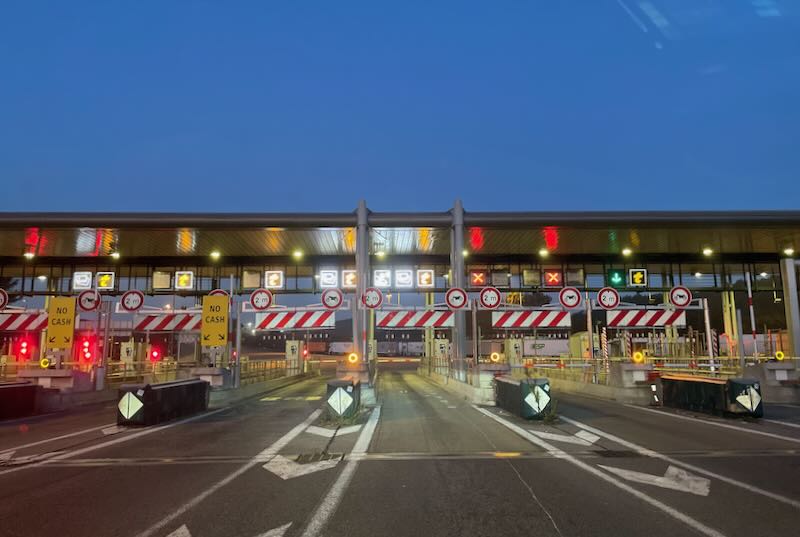
What to expect at toll booths
These days, few toll roads are manned by humans so if you have a problem with any of the above, well... you'll have to wait for someone from the little building on the side to come out and see what all the honking is about. Or, use the microphone, but most attendants speak only French. They'll still send someone out if there's a problem. They might take a while to answer, but keep trying.
Driving in French cities vs. rural areas
France is a country of terrifically scenic roads, of achingly lovely villages, of soaring mountains and crystal lakes and to get to most of it, you'll need a car to head off beyond the autoroute.
Driving in major French cities (Paris, Marseille, Lyon...)
You may be tempted to use your car in the city. Don't.
Find accommodations with parking, park your car, and use it only to go on day trips or to travel to your next destination.
Cities have massive traffic jams, impatient drivers (especially if you don't know exactly where you're going), scarce and expensive parking lots, and poor signage. Unless you're looking for this type of adventure, save your stress for other occasions.
French cities tend to have excellent public transportation systems so use those instead.
Navigating rural roads and villages
French roads are often narrower than you may be used to and have plenty of blind spots. Don't be surprised to see a bus hurtling towards you around a sharp mountainous bend. Don't worry, you are both in the right place. One of you may have to reverse — usually the smaller vehicle.
That also happens on hills. Usually, the vehicle going up has priority. Unless the vehicle coming down is larger, or is pulling a trailer, or is a tractor, or... you get the gist.
If someone is barrelling towards you and clearly has no intention of stopping, give them the benefit of the doubt, and squeeze aside.
And then there are the many unexplained priorities. I once lived in a pedestrian-only medieval village. Residents were allowed to drive in, but there was no sign that said so. So each time I drove into my village, I'd get yelled at and even insulted by tourists pointing to the 'no automobiles' sign.
I'm not saying any of this to scare or confuse you. It's just that on rural roads, where traffic is scarce, locals may have their way of doing things and it would be wise to take it easy until you understand what those peculiarities are.
Sharing the road with cyclists
As you drive, you may see groups of 2 to 20 cyclists huffing and puffing their way up a mountain road steep enough to scare even a goat. Cycling is a national sport and you ignore that at your peril.
To pass a posse of cyclists, please be patient and wait until there is a safe place to pass the entire group, and that might be a long way uphill. Once you can pass, make sure you leave 1.5m (5ft) between you and the cyclists.
And please, don't cheer them on by honking. You'll surprise them and someone might fall off...
What if there's a solid line in the middle of the road?
According to a gendarme friend of mine, just keep your two right tires on the right side of the solid line as you pass, with only your two left tires over the line. (Just for info, you can pass a cyclist on a solid line but not a farm tractor going five an hour.) I hope he's right because that's what I've been doing.
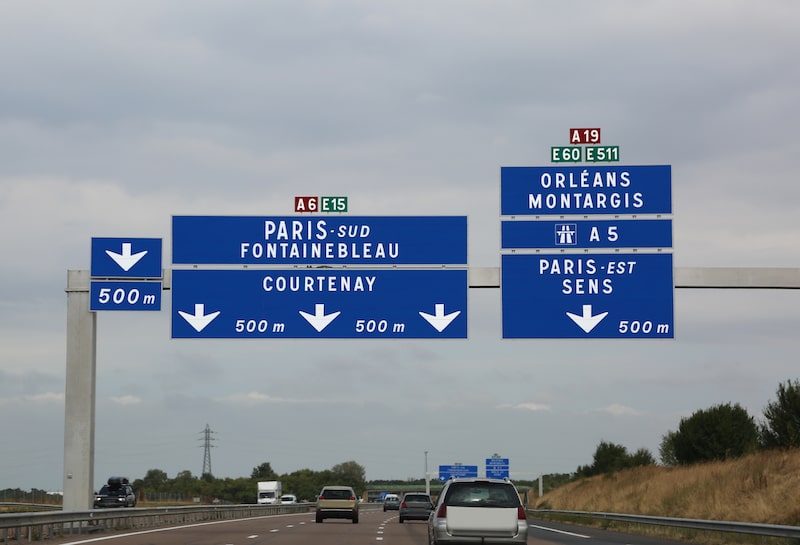
IF YOU'RE PLANNING TO DRIVE IN FRANCE...
This online course is a quick and enjoyable way for you or your second driver to learn our driving rules. I live and drive in France, and even I learned things to make my road trips more enjoyable, safer and less stressful. Find out more here.
Parking in France
I remember as a child, my father parked by sound. When he heard the scrunch of his bumper against the car in front of him, he stopped and reversed until he heard the thump of the car behind him. Inch by inch he would squeeze into an unnaturally tiny space.
Things are now done differently and today, we have lines painted on the ground, and we're a lot more organized about how we park.
Where to park in French cities
If you do need to park a car in the heart of a French city, here are a few considerations.
How high is your car? I ask because many parking garages here are extremely low, and the sign that gives you the height is extremely tiny. Trust me on this; once you get stuck in a parking garage entrance, it is both costly and embarrassing to be rescued.
Some garages can only clear 1m80, which is passable for a small car but anything slightly larger, including city SUVs, will not fit. Ask your car rental agent for your car's height before you drive off, and check before you start down any ramp! The height limit sign will usually be overhead or to your right.
Street parking may not be free. Search for a meter — you'll usually have to feed it and it's often at the end of the street, or hidden from view. The word "payant" means you have to pay.
There are two main kinds of meter: one that asks for your licence plate number and your money, and one that asks only for your money. Both will usually deliver a ticket you place inside your windshield (although some of the modern ones are electronic and register your licence plate without the need of a ticket).
These machines are notoriously confusing, even for us, so don't hesitate to ask someone for help. Everyone has fought with parking meters at some point so they should feel a bit of sympathy for you.
Parking fees and enforcement
Sometimes, the parking meters don't work, but this is NOT considered a valid reason for not having a ticket. You are expected to find another meter and use that one. Last week, I found three broken meters in a row and concluded that even the police must realize the problem. Thankfully my theory wasn't tested, because fines can range from €35-€75.
If parking spaces are separated by blue lines, this means you can park for free for two hours but you'll need to place a blue disk on your dashboard that indicates the time you arrived – you can buy these at gas stations or tobacco stores. You'll get fined if you park in a "blue" space without one (unless it's during lunch or after 7pm).
Traffic violations and fines
Our fines are hefty and if you live overseas, you might be tempted to evade them. Don't. Most times, you'll be charged on the spot and if you can't pay, your car might be confiscated until you can.
Speeding fines
Speeding fines in France can be quite high, even though people often ignore speed limits. Radars are making it easier to catch speeders these days...
The lowest speeding fine is €68, and the highest €3750, with plenty in-between depending on how fast you were going, what the speed limit was, whether you were on a road or in an urban area...
Since the police is allowed to fine you then and there, its best not to test the system.
If a radar catches you, on the other hand, it's more of a gray area. You may get away with a minor offence unless your country has a reciprocal agreement with France, in which case you'll get your fine in the mail.
Otherwise... the authorities may think it's simply not worth pursuing you to the ends of the earth. But I wouldn't take the chance.
Drinking and driving in France
Laws against drunk driving in France are very strict.
The blood alcohol limit is 50mg of alcohol in 100ml of blood (even less if you're a new driver or on probation). That's two glasses of wine or beer.
Drivers who are over the limit risk a maximum penalty of three years in jail and a €9000 fine, in addition to all sorts of other penalties like losing your licence and even your car.
The notion of designated driver is still not as widespread as it should be, especially in my rural area, when people rush home for dinner after apéro time in the local café.
Timing is important, and you'll usually find the worst drivers:
- right after lunch (that lunchtime wine)
- right before dinner (rushing home after aperitif time)
- right after dinner out (dinner drinks)
- late on Friday and Saturday evenings (when people leave bars and discos at closing time)
Despite our robust rules, some 30% of fatal accidents on French roads are alcohol related, and three-quarters are caused by young men.
The good news is that these numbers are dropping. I can't imagine what they were like before. To be fair, I do occasionally hear someone say, "I'm not drinking because I'm driving." But it's still quite the exception, at least in my corner of the countryside.
Talking on mobile phones
Penalties are stiffening, and some drivers actually demonstrate guilt as they reach for their mobiles while steaming down the autoroute.
Let's be real: 7 in 10 French drivers (more women than men in this case) admit they've used their phones while driving.
The penalty is a loss of points on a licence (in France you lose points when you're caught disobeying road rules) and a fine, although if you're involved in an accident while talking or texting, you could at the very least lose your licence.
For many French, that's a pinprick and not enough to sit up and take notice. So drive defensively.
Tips for renting a car in France
Many places in France can be reached by train, but not all, especially you want to visit some of our more offbeat corners.
If you don't have your own car, you'll have to rent one, but before you do, please read this piece about things you should know before renting a car in France.
CAR RENTAL IN FRANCE TIPS
If you plan to rent a car, compare rental car costs first, because they vary widely depending on whether you rent downtown or at the airport, in urban areas or the suburbs, or in one part of France as opposed to another. This is the comparison engine I use.
If you're not ready to rent and just want a few car rental in France tips, please continue reading.
What I do is walk around the car and take a video of every little scratch with my phone. Most rental agencies are perfectly honest, but it gives me that extra confidence. You know, the 'just-in-case' factor.
Before you drive off, spend a few minutes becoming familiar with the car, the stick shift, the lights and windshield wipers. You don't want to wait until a downpour to figure out where the wipers are.
Insurance tips for car rentals
Before you rent, first check is whether your credit card or home insurance covers your car hire. Rental prices can double once you add the insurance and who knows, you might already be covered by your credit cards or home insurance.
Choosing the right car for French roads
If you're from Canada or the United States, beware the size of car you rent. The car rental agent may think s/he is being helpful by offering you the bigger luxury car at the same price — careful.
French roads are not designed for larger vehicles and many villages were not built for cars at all. Try getting your SUV stuck in a tiny medieval cobblestone alley with no room to turn around and you'll desperately wish you'd rejected the upgrade.
You probably know this, but here's a reminder: most French cars have manual transmissions. These days, car rental companies will usually stock a few automatics but you may have to pay extra, and because they are scarce, there might not be any when you need one. This, however, is slowly evolving and automatic cars are becoming increasingly available.
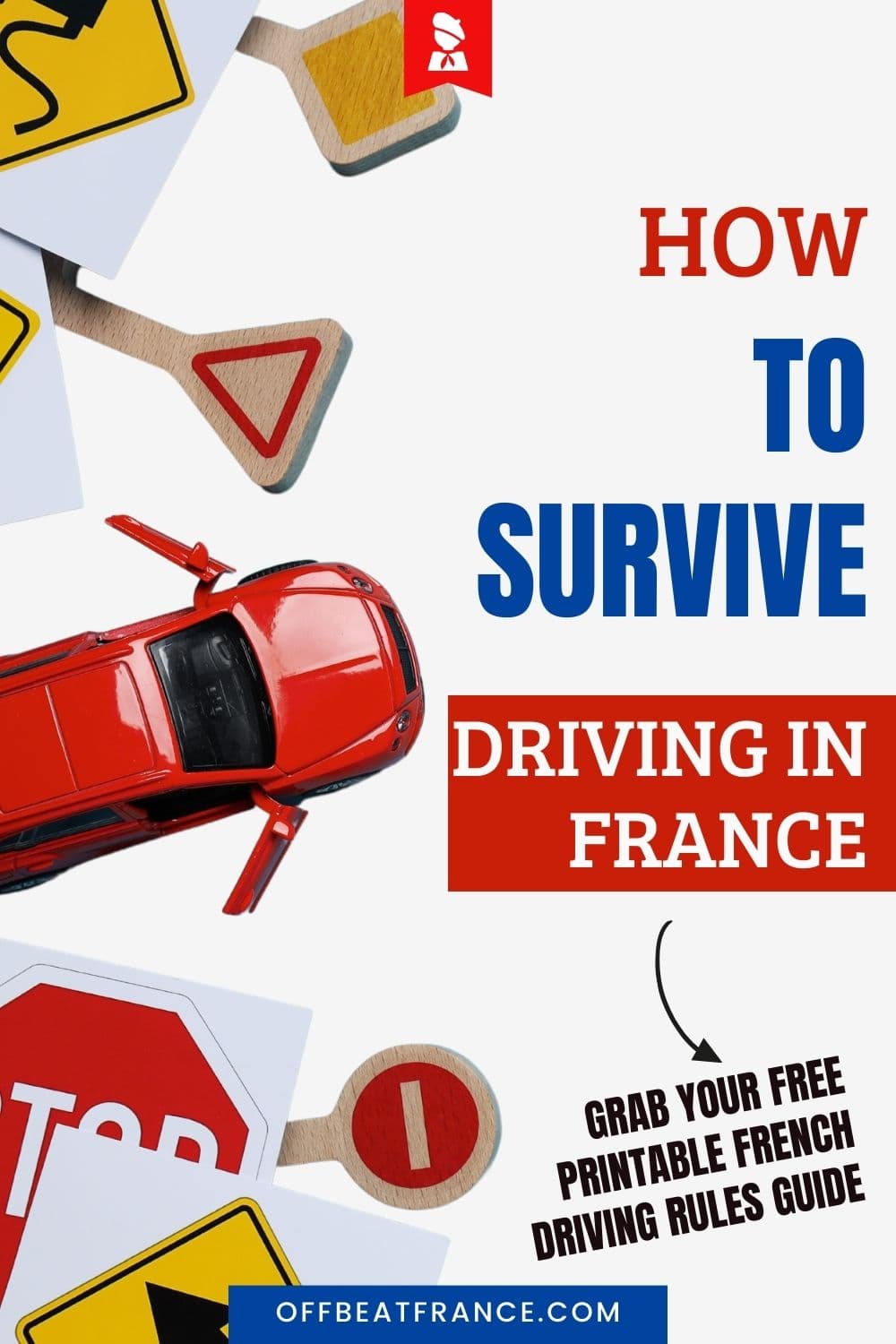
Driving through scenic routes in France
French roads cut through some of the most breathtakingly gorgeous countryside on the planet.
And, these roads are usually of excellent quality.
While there are regional differences, roads in my own region near the Alps are beautifully maintained. Each year, the worst patches get resurfaced and lines redrawn.
You may need to use the autoroutes to get from A to B quickly, but if you want to really see France, you'll head for the country roads.
Best road trips in France
This is where you'll enjoy the best French road trips, surrounded by a bucolic beauty that belongs on postcards: spotless scenery, lovely villages and farms, majestic monuments, stunning castles.
For example, the gorgeous hilltop villages of the Luberon can only be reached by car... or these wonderful off the beaten path destinations which many foreign visitors have never been to.
It's all there, and driving is the best way to see it.
And finally, don't trust GPS systems without a backup, like Google maps or a reliable paper map of France. I've spent many an hour wandering around an industrial area trying to get out...
On the other hand, driving in France as a tourist can be great fun – going on an adventure and letting your GPS lead the way can lead to plenty of discoveries and is a wonderful way to discover France's more offbeat corners.
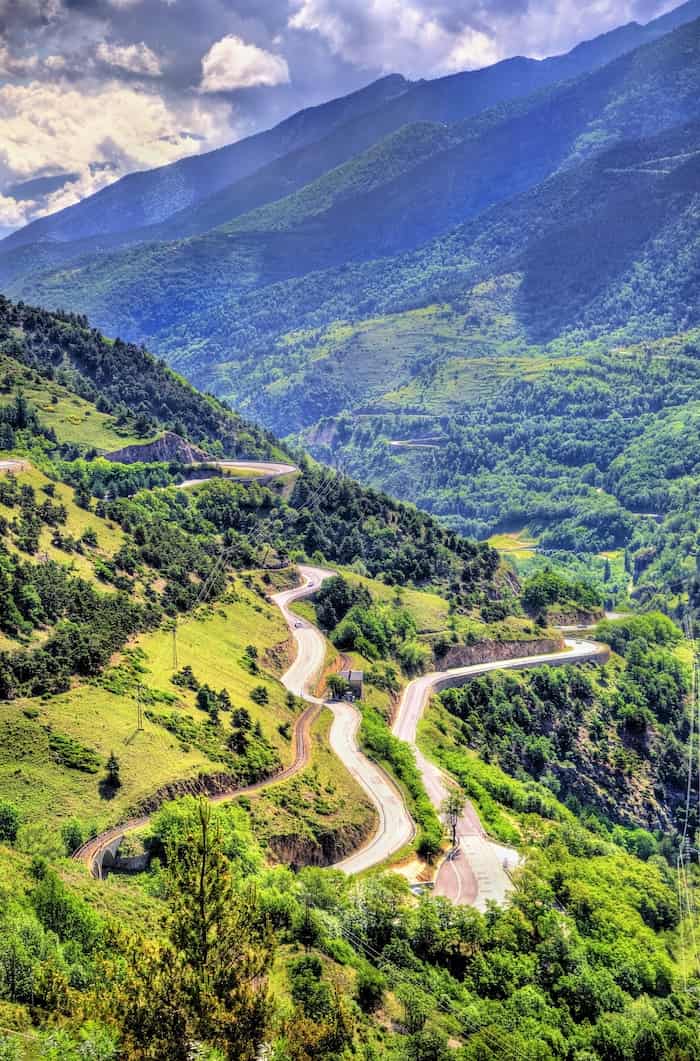
What to know when driving in winter
If you happen to be driving here in winter, you'll need to take special care. There is a new winter tire/chain law. In some départements, between 1 November and 31 March, you must either have snow tires, all-season tires, or carry chains in your car. (Here's the official French government page that describes it all – in French of course.)
Roads have pull-offs where you can stop and put your chains on, but make sure you actually know how. I've struggled with new chains in sub-zero temperatures, my frozen fingers barely able to attach them.
Traveling France by car: Useful resources
- Rules for driving in France
- How the French government explains it all
- French motorway website
- Even more French driving tips
- Via Michelin route planner
FAQs about driving in France
Is driving in France easy?
Is it easy to drive in France? Not exactly, but it is perfectly manageable as long as you become familiar with the rules of the road and drive with care. It's not seamless, and quite a few of the rules are different.
Can tourists drive in France?
Yes, with a valid driver’s license.
But your licence should either be in French, or have a French translation. The easiest way to do this is to get an International Driving Permit, or IDP, in your own country before leaving. The IDP contains your photo and the text of your driving license in a dozen languages.
Which side of the street do they drive on in France?
The French drive in the right lane, like the US and Canada.
What is the legal driving age in France?
In most cases, the minimum age for driving in France age is 18. But there are certain types of accompanied driving solutions that allow those who have undergone training and a driving test to drive at 17.
Before you go...
We've just looked at a few basic rules, but not everything is a rule. Some things are just useful to know, and others are things you may not have thought of.
I suggest you drive defensively, however in the right you may think you are, and remember, you're a foreigner, not a local who knows the usage rules for their towns and villages.

